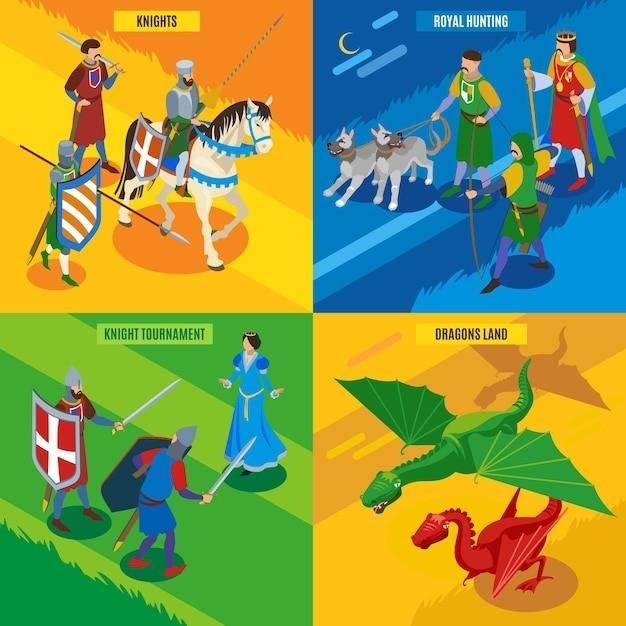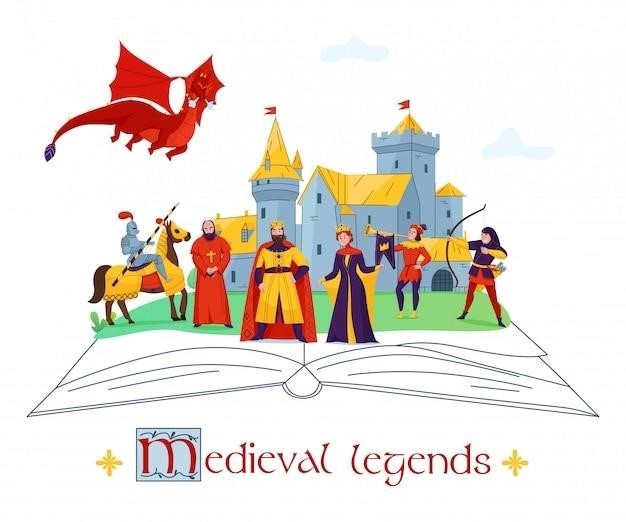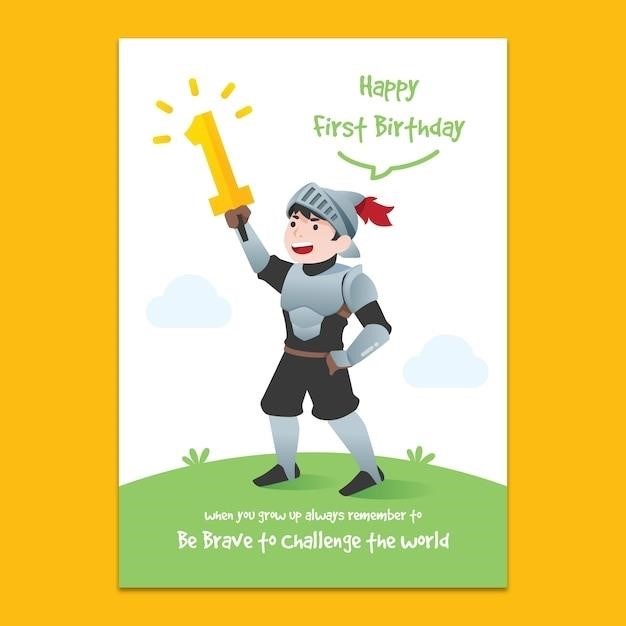Sir Gawain and the Green Knight⁚ Tolkien’s Edition
J.R.R. Tolkien’s edition of Sir Gawain and the Green Knight‚ a classic of Arthurian literature‚ is a testament to his deep love for Middle English and his expertise in the field. The 1925 edition‚ co-edited with E.V. Gordon‚ is considered a landmark in Arthurian scholarship. Tolkien’s meticulous editing‚ combined with Gordon’s insightful notes‚ provided a comprehensive and accessible text for readers. The edition’s impact on the study of Sir Gawain and the Green Knight has been profound‚ shaping its interpretation and sparking ongoing scholarly interest.
The Poem’s History and Significance
Sir Gawain and the Green Knight‚ a late 14th-century Middle English alliterative romance poem‚ holds a prominent place in Arthurian literature. It’s a captivating tale of chivalry‚ adventure‚ and moral dilemmas‚ set against the backdrop of King Arthur’s legendary court. The poem’s anonymous author‚ often referred to as the Pearl Poet‚ skillfully weaves together elements of courtly romance‚ medieval folklore‚ and Christian allegory. The poem’s enduring popularity is attributed to its compelling narrative‚ vivid imagery‚ and exploration of universal themes.
The story revolves around Sir Gawain‚ a valiant knight of King Arthur’s Round Table‚ and his encounter with the enigmatic Green Knight. The Green Knight‚ a mysterious figure with verdant skin and an axe‚ challenges the knights of Camelot to a beheading game‚ offering a year and a day for whoever accepts. Gawain‚ eager to prove his courage‚ accepts the challenge. The poem then follows Gawain’s journey to the Green Chapel‚ where he must face the Green Knight’s return blow.
Sir Gawain and the Green Knight is a complex and multi-layered work. It delves into themes of chivalry‚ honor‚ temptation‚ and the struggle between worldly desires and spiritual obligations. The poem’s intricate structure‚ with its parallel scenes of hunting and temptation‚ adds further layers of meaning. The poem’s significance lies not only in its literary merit but also in its reflection of medieval society‚ its values‚ and its understanding of chivalry and virtue.
J.R.R. Tolkien’s Involvement
J.R.R. Tolkien‚ best known for his epic fantasy works like The Lord of the Rings‚ played a significant role in the revival and scholarly understanding of Sir Gawain and the Green Knight. His interest in the poem stemmed from his deep knowledge of Old and Middle English‚ his passion for the Arthurian legend‚ and his fascination with language and its evolution. Tolkien’s academic pursuits‚ particularly his work on the history of English language‚ led him to the study of Middle English literature‚ where Sir Gawain and the Green Knight captivated his attention.
Tolkien’s involvement with the poem began in the 1920s‚ when he embarked on a collaborative project with E.V. Gordon‚ a fellow scholar and enthusiast of Middle English literature. Their shared passion for the poem ignited a project that would result in a groundbreaking edition of Sir Gawain and the Green Knight‚ published in 1925. Tolkien’s expertise in the language and his meticulous attention to detail were instrumental in establishing a definitive text for the poem.
Tolkien’s contributions went beyond simply editing the text. He delved into the poem’s language‚ its meter‚ and its structure‚ uncovering its hidden layers of meaning and its unique literary qualities; His work on Sir Gawain and the Green Knight demonstrated his deep understanding of Middle English literature and his commitment to preserving and illuminating its richness for future generations.
The 1925 Edition⁚ Collaboration and Impact
The 1925 edition of Sir Gawain and the Green Knight‚ a collaborative effort between J.R.R. Tolkien and E.V. Gordon‚ marked a turning point in the study of this medieval masterpiece. This edition‚ published by the Clarendon Press in Oxford‚ presented a meticulously edited text alongside comprehensive notes and a glossary. Tolkien‚ with his expertise in Middle English‚ focused on establishing a reliable text‚ while Gordon‚ known for his insightful interpretations‚ provided detailed annotations. Their combined efforts produced a scholarly edition that made the poem accessible to a wider audience and sparked renewed interest in its study.
The 1925 edition’s impact on the study of Sir Gawain and the Green Knight was profound. It became the standard text for scholars and students‚ providing a foundation for future research and interpretation. The edition’s thoroughness and clarity helped to demystify the poem’s language and structure‚ allowing readers to engage with its complex themes and literary artistry. Tolkien and Gordon’s work also highlighted the poem’s significance as a unique example of Middle English literature‚ showcasing its rich vocabulary‚ intricate alliteration‚ and captivating storytelling.
The 1925 edition‚ a testament to the collaborative spirit of scholarly research‚ remains a vital resource for those seeking to explore the depths of Sir Gawain and the Green Knight. It continues to inspire new interpretations and analysis‚ solidifying the poem’s place as a cornerstone of medieval literature and a testament to the enduring power of storytelling.
The Text and Its Features
The text of Sir Gawain and the Green Knight‚ as presented in Tolkien’s edition‚ is a marvel of Middle English literature. The poem‚ written in the late 14th century‚ showcases the rich vocabulary and intricate grammar of the period. One of its most striking features is its use of alliteration‚ where the initial sounds of words are repeated throughout a line‚ creating a rhythmic and memorable effect. This alliterative verse‚ characteristic of the time‚ gives the poem a distinct musicality and contributes to its powerful storytelling.
Beyond its linguistic features‚ the text is notable for its intricate structure and symbolism. The poem’s narrative unfolds through a series of intertwined themes‚ including chivalry‚ temptation‚ and the search for self-knowledge. The story’s central conflict‚ a beheading game between Sir Gawain and the Green Knight‚ serves as a metaphor for the trials and temptations faced by every knight in the pursuit of honor and virtue. The poem’s use of symbolism‚ such as the green girdle‚ adds layers of meaning and invites readers to engage with its allegorical depth.
Tolkien’s meticulous editing ensured the accuracy and clarity of the text‚ making it accessible to a wider audience. His edition‚ along with Gordon’s detailed notes‚ provided readers with a rich understanding of the poem’s historical and literary context. The text’s enduring appeal lies in its timeless themes‚ its captivating storytelling‚ and its remarkable linguistic artistry‚ offering a window into the rich tapestry of medieval culture and literature.

The Green Knight and the Beheading Game

The Green Knight‚ a figure of enigmatic power and otherworldly presence‚ is the catalyst for Sir Gawain’s perilous journey. His arrival at King Arthur’s court‚ during the festive season of Christmas‚ disrupts the idyllic atmosphere with a challenge that tests the very essence of chivalry. The Green Knight‚ clad in emerald armor and riding a steed of the same hue‚ presents a beheading game‚ a dangerous proposition that demands courage and a willingness to confront one’s mortality.
The Green Knight‚ a figure of enigmatic power and otherworldly presence‚ is the catalyst for Sir Gawain’s perilous journey. His arrival at King Arthur’s court‚ during the festive season of Christmas‚ disrupts the idyllic atmosphere with a challenge that tests the very essence of chivalry. The Green Knight‚ clad in emerald armor and riding a steed of the same hue‚ presents a beheading game‚ a dangerous proposition that demands courage and a willingness to confront one’s mortality.
The beheading game‚ a peculiar and unsettling ritual‚ sets the stage for a complex narrative of chivalry‚ temptation‚ and the pursuit of self-knowledge. Sir Gawain‚ driven by his sense of honor and his desire to uphold the reputation of the Round Table‚ accepts the Green Knight’s challenge‚ a decision that will lead him on a year-long quest‚ testing his courage‚ his loyalty‚ and his very soul.
Sir Gawain’s Trials and Temptations
Sir Gawain’s journey to the Green Chapel is a testament to the power of temptation and the fragility of human virtue. The Green Knight’s challenge‚ a year-long quest to find the Green Chapel and receive a blow in return for the one he dealt‚ is fraught with danger and uncertainty. Along the way‚ Gawain encounters a series of temptations that test his resolve‚ his commitment to chivalry‚ and his inner strength.
The most significant temptation Gawain faces is the seductive allure of the Lady of the Castle‚ a beautiful and cunning woman who tests his loyalty and moral compass. She tempts him with luxurious comforts‚ lavish gifts‚ and a seductive charm‚ challenging his commitment to his quest and his vows to Arthur and the Round Table. Gawain’s struggle with temptation‚ his inner conflict between his sense of honor and his desire for pleasure‚ is a central theme of the poem.
The poem explores the complex nature of temptation‚ highlighting the power of desire and the internal struggle between virtue and vice. Gawain’s trials and temptations offer a nuanced portrayal of human frailty and the difficulty of resisting temptation‚ even in the face of profound moral commitments.
Themes of Chivalry‚ Honor‚ and Temptation
Sir Gawain and the Green Knight delves into the complex interplay of chivalry‚ honor‚ and temptation‚ offering a nuanced exploration of these themes through the protagonist’s journey. The poem’s central figure‚ Sir Gawain‚ embodies the ideals of chivalry‚ a code of conduct that emphasizes courage‚ loyalty‚ and courtesy. He is a knight of the Round Table‚ bound by his vows to King Arthur and the code of chivalry‚ and his actions throughout the narrative are measured against these ideals.
The Green Knight’s challenge‚ a year-long quest to find the Green Chapel and receive a blow in return for the one he dealt‚ tests Gawain’s commitment to chivalry. The quest itself is a trial of courage and perseverance‚ but Gawain’s encounters with temptation‚ particularly the seductive allure of the Lady of the Castle‚ challenge his commitment to honor. The poem underscores the tension between the knight’s oath to chivalry and the powerful allure of temptation‚ showing how even the most noble knight can be susceptible to human weakness.
The poem’s exploration of these themes resonates with readers even today‚ offering timeless insights into the complexities of human nature and the struggle to uphold ideals in the face of temptation.
Tolkien’s Translation and Interpretation
J.R.R. Tolkien’s involvement with Sir Gawain and the Green Knight extended beyond mere editing. His translation and interpretation of the poem revealed his deep understanding of the language‚ culture‚ and literary conventions of the Middle Ages. Tolkien’s translation aimed to capture the spirit and beauty of the original Middle English text while making it accessible to a wider audience. He meticulously crafted his translation to reflect the poem’s alliterative structure and its rich imagery.
Tolkien’s interpretation of the poem demonstrated his keen eye for symbolism and his belief in the importance of understanding the poem’s context within the broader Arthurian tradition. He saw Sir Gawain and the Green Knight not simply as a story of adventure but as a profound exploration of themes of chivalry‚ honor‚ and temptation. Tolkien’s insights into the poem’s symbolism‚ particularly the significance of the Green Knight and the Lady of the Castle‚ have shaped scholarly understanding of the work.
Tolkien’s translation and interpretation of Sir Gawain and the Green Knight have left an enduring legacy‚ contributing significantly to the poem’s enduring popularity and its continued study in the academic world.
The Legacy of Sir Gawain and the Green Knight
Sir Gawain and the Green Knight continues to hold a prominent place in English literature and Arthurian lore. The poem’s enduring appeal stems from its masterful blend of adventure‚ chivalry‚ and psychological depth. It is a story that resonates across time‚ exploring universal themes of honor‚ temptation‚ and the complexities of human nature.
Tolkien’s edition of Sir Gawain and the Green Knight has played a significant role in the poem’s legacy. His meticulous scholarship and insightful interpretations have ensured that the poem remains accessible and relevant to modern readers. The edition has also sparked ongoing scholarly discussion and inspired numerous adaptations and interpretations in various media‚ including film‚ theatre‚ and music.
The poem’s enduring popularity is a testament to its enduring power. It continues to captivate readers with its rich language‚ its compelling characters‚ and its timeless themes. Sir Gawain and the Green Knight remains a vital part of the Arthurian tradition‚ inspiring generations of readers and scholars with its enduring power and its timeless appeal.

Leave a Reply